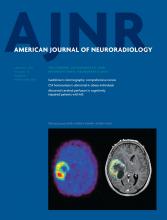Research ArticleNeurointervention
The Clinical and Radiographic Importance of Distinguishing Partial from Near-Complete Reperfusion Following Intra-Arterial Stroke Therapy
M.V. Jayaraman, J.A. Grossberg, K.M. Meisel, A. Shaikhouni and B. Silver
American Journal of Neuroradiology January 2013, 34 (1) 135-139; DOI: https://doi.org/10.3174/ajnr.A3278
M.V. Jayaraman
aFrom the Departments of Diagnostic Imaging (M.V.J.)
bNeurosurgery (M.V.J., J.A.G., A.S.)
J.A. Grossberg
bNeurosurgery (M.V.J., J.A.G., A.S.)
K.M. Meisel
cNeurology (K.M.M., B.S.), Warren Alpert School of Medicine at Brown University, Rhode Island Hospital, Providence, Rhode Island.
A. Shaikhouni
bNeurosurgery (M.V.J., J.A.G., A.S.)
B. Silver
cNeurology (K.M.M., B.S.), Warren Alpert School of Medicine at Brown University, Rhode Island Hospital, Providence, Rhode Island.

References
- 1.↵
- Furlan A,
- Higashida R,
- Wechsler L,
- et al
- 2.↵
- del Zoppo GJ,
- Higashida RT,
- Furlan AJ,
- et al
- 3.↵
- Flint AC,
- Duckwiler GR,
- Budzik RF,
- et al
- 4.↵
Penumbra Pivotal Stroke Trial Investigators. The Penumbra Pivotal Stroke Trial: safety and effectiveness of a new generation of mechanical devices for clot removal in intracranial large vessel occlusive disease. Stroke 2009;40:2761–68
- 5.↵
- Ogawa A,
- Mori E,
- Minematsu K,
- et al
- 6.↵
- Nogueira RG,
- Liebeskind DS,
- Sung G,
- et al
- 7.↵
- Higashida RT,
- Furlan AJ,
- Roberts H,
- et al
- 8.↵
- Kasner SE,
- Cucchiara BL,
- McGarvey ML,
- et al
- 9.↵
- Berger C,
- Fiorelli M,
- Steiner T,
- et al
- 10.↵
- Fiorelli M,
- Bastianello S,
- von Kummer R,
- et al
- 11.↵
- Hacke W,
- Kaste M,
- Fieschi C,
- et al
- 12.↵
- Tomsick T,
- Broderick J,
- Carrozella J,
- et al
- 13.↵
- Arnold M,
- Nedeltchev K,
- Remonda L,
- et al
- 14.↵
- Fields JD,
- Lutsep HL,
- Smith WS
- 15.↵
- Yoo AJ,
- Verduzco LA,
- Schaefer PW,
- et al
- 16.↵
- 17.↵
- Albers GW,
- Thijs VN,
- Wechsler L,
- et al
- 18.↵
- Shaltoni HM,
- Albright KC,
- Gonzales NR,
- et al
- 19.↵
- Tomsick T
- 20.
- Smith WS,
- Sung G,
- Saver J,
- et al
- 21.
- Lewandowski CA,
- Frankel M,
- Tomsick TA,
- et al
- 22.
IMS II Trial Investigators. The Interventional Management of Stroke (IMS) II Study. Stroke 2007;38:2127–35
In this issue
Advertisement
M.V. Jayaraman, J.A. Grossberg, K.M. Meisel, A. Shaikhouni, B. Silver
The Clinical and Radiographic Importance of Distinguishing Partial from Near-Complete Reperfusion Following Intra-Arterial Stroke Therapy
American Journal of Neuroradiology Jan 2013, 34 (1) 135-139; DOI: 10.3174/ajnr.A3278
0 Responses
Jump to section
Related Articles
Cited By...
- Efficacy of Cerebrolysin Treatment as an Add-On Therapy to Mechanical Thrombectomy in Patients With Acute Ischemic Stroke Due to Large Vessel Occlusion in Anterior Circulation: Results of a three-month follow-up of a Prospective, Open Label, Single-Center Study
- Prognostic Scores for Large Vessel Occlusion Strokes
- Small thrombus size, thrombus composition, and poor collaterals predict pre-interventional thrombus migration
- Systematic review and meta-analysis on outcome differences among patients with TICI2b versus TICI3 reperfusions: success revisited
- Rethinking Thrombolysis in Cerebral Infarction 2b: Which Thrombolysis in Cerebral Infarction Scales Best Define Near Complete Recanalization in the Modern Thrombectomy Era?
- Risk of Thrombus Fragmentation during Endovascular Stroke Treatment
- Time to redefine success? TICI 3 versus TICI 2b recanalization in middle cerebral artery occlusion treated with thrombectomy
- 2015 American Heart Association/American Stroke Association Focused Update of the 2013 Guidelines for the Early Management of Patients With Acute Ischemic Stroke Regarding Endovascular Treatment: A Guideline for Healthcare Professionals From the American Heart Association/American Stroke Association
- Acute Ischemic Stroke: Time, Penumbra, and Reperfusion
This article has not yet been cited by articles in journals that are participating in Crossref Cited-by Linking.
More in this TOC Section
Similar Articles
Advertisement











